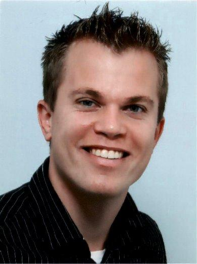Superconducting and topological hybrids
Promotion date: 19. September 2012
Promotors: Prof. dr.ir. Alexander Brinkman and Prof. dr.ir Hans Hilgenkamp
| In 1926 Albert Einstein posed: “A question of particular interest is whether the interface between two superconductors becomes superconducting as well”. Brian Josephson came with the answer, honored with a Nobel price, and this year celebrated as fifty years of Josephson effects. Still, these systems are fascinating and can lead to new phenomena by using specific materials that connect the superconductors, such as the recently discovered topological insulators. In this thesis, these systems are studied, possessing opportunities to realize phenomena ranging from spatially separated entangled particles that can be used for quantum teleportation to the enrichment of condensed matter physics with a new emergent particle, sought since the prediction of its existence in 1937: the elusive Majorana fermion. |
The phenomenon you studied is special.
Interface physics is a fascinating field with tremendous possibilities. During my thesis I studied the electrical characteristics of several material’s combinations, with the strongest emphasize on superconductors. One of the most intriguing results was the realization of inducing superconductivity in the recently discovered topological insulators.
Topological insulators exhibit very exotic properties; where the bulk of this material, the interior, is electrically insulating, just on the surface it is electrically conducting. These electrons on the surface have a spin, which is coupled to the direction in which they move. We managed to make this surface superconducting by putting, via e-beam nanolithography, superconducting leads on such a topological insulator. I was very excited to see the vanishing of the electrical resistance of the topological insulator by the induction of superconductivity. At that moment I tried to telephone and contact as many people as possible to share this great news.
In Holland your work attracted some media attention.
There is a world-wide hunt to observe a new emergent particle in solid-state physics: the Majorana fermion. This particle can emerge out superconductor – topological insulator devices, and we were the first to observe the so-called ac and dc Josephson effects in these systems. These experiments are an important step towards the detection of the Majorana fermion.
Where were your findings published?
I have published as first author for example in Nature Materials, Physical Review Letters, Applied Physics Letters and Physical Review B. Based on these results we are regularly invited to present on international conferences; in July for example I presented at the M2S in Washington.
What are your future plans?
In October I will move to Sydney to work as a postdoctoral researcher on silicon quantum electronics, where I hope to realize silicon quantum teleportation. Sydney is of course famous for its state-of-the-art nanolithography equipment and cryogenic tools, but it is also located in a nice environment with good weather conditions.
What, in your opinion, is important for Mesa+ to stay successful in future?
The Mesa+ centre holds great facilities and vast knowledge and combines a variety of groups with different research directions. I believe this diversity combined in one centre is unique and very important. During my Ph.D. period, the Mesa+ institute offered both the expertise and the equipment needed to carry out the experiments and I hope this will also be warranted in the future.

